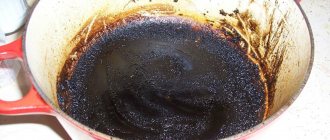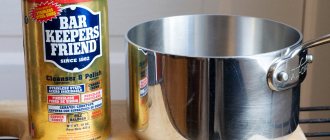The taste of jam is influenced not only by high-quality ingredients and correct adherence to the recipe, but also by the container in which it is prepared. If you choose the container correctly, the fruit preparation will never burn, and its thickness will be ideal. Experienced housewives have long noticed that one vessel is optimal for making jam, but you should avoid using another. When choosing, it is important to take into account the material of the utensil, its volume, shape and a number of other features. Only by understanding all the rules and subtleties of using a particular container can you learn how to make the perfect jam from any berries and fruits.
Shape and volume of containers for making jam
In large quantities, delicate berries will be crushed, so experienced housewives never prepare 6-10 kg of jam. The more delicate the main ingredient, the smaller the portion should be. It is advisable to cook strawberries, wild strawberries and raspberries in a maximum of 2 kg each , and apricots, cherries, currants and plums - 3 kg each.
For a small portion of jam, a container with a volume of 4-4.5 liters is sufficient. If you like to make blanks in large batches, look for a six-liter container. It’s better to spend more time on two batches, but prepare delicious preparations for the winter.
The correct container for making jam should be shallow, but wide - like a basin. In such a container, excess moisture will evaporate faster, and the pieces of fruit will not be damaged, they will warm up evenly and are soaked in sugar syrup. Tall pots and shaped dishes with the bottom and top much narrower than the sides are not suitable.
Lids are not used during the cooking process, but they can be useful at the stage when the berries are covered with sugar or jam for several hours and infused in syrup. But if a suitable container does not have a lid, it doesn’t matter, you can cover it with a towel or choose another lid.
Handles make it easy to turn the jam on the stove and remove it from the oven. If they are not there, then there should be a neck that you can grab with your hands using oven mitts.
How to remove burnt sugar from the bottom of the container
Here are a few more folk methods for cleaning sugar that has burnt during cooking, which can be used without using commercial chemicals.
- Vinegar in its pure form and concentration of 9% is able to cope with stains of any complexity. It is enough to pour the undiluted substance into the “affected” pan and leave for several hours. If necessary, you can use a brush with medium-hard bristles.
- Baking soda powder will also help get rid of the sugar crust. A sufficient amount of it (about half a glass) is poured onto the bottom, poured with water so that it covers the contaminated space, and boiled until the sugar begins to lag behind.
- Salt solution. It is necessary to dilute six tablespoons of rock salt in one liter of liquid, then cook the mixture over medium heat for 40-50 minutes.
- The same method is used with citric acid, only the number of crystals increases to 100 grams.
- Activated carbon can get rid of the problem in an hour. It is crushed (the number of tablets directly depends on the area of the damaged surface), sprinkled on the bottom, and left for 0.5 hours. Then add water and let it brew for the same amount of time.
- The apple or its peel contains a sufficient amount of acid, which perfectly removes soot and fat. In order to get rid of contaminants, cut the fruit, add liquid and cook this “compote” for a quarter of an hour. Burnt jam will come off easily after the specified time if you pry it off with a spatula.
Advice: you should get rid of carbon deposits as soon as possible, without leaving the dishes dirty for a long time, otherwise yellow spots will remain on their surface in places where they were previously dirty.
Now you know about the basic ways to care for dishes if they have trouble in the form of food burning. There are other methods that can be used to quickly remove the consequences of such “accidents”, as described in numerous videos on the Internet.
Be attentive not only to what exactly you cook, but also in what. After all, with regular care, your dishes will last for many years. Good luck!
Did you like the article? Save it to your Pinterest! Hover over the image and click Save.
Ideal utensil material for jam
When choosing the right container for making jam, it is important to take into account the specifics of the recipe. There are methods of cooking in one step, and there are recipes that require heating three times with infusion in between boiling. If you cannot leave the jam in the bowl overnight, you will have to pour it into a different pan each time.
Copper basin - a classic of the genre
In ancient cookbooks, you most often find recommendations for choosing copper utensils for jam. This was passed down from grandmother to granddaughter. Advantages:
However, today they look at copper differently and it is impossible to say that a copper basin is the best choice for preserves and jams. During heat treatment, copper ions react with acids, destroying vitamins. In low-quality kitchen utensils, copper oxides that are hazardous to health may enter the food during cooking.
To prevent oxidation, tinned copper bowls with an internal coating should be used for heat treatment of fruits and berries. Most often, tin - a metal that can be restored. Not long ago, manufacturers learned to coat copper with stainless steel. This one is not afraid of acids. But all copper products require careful handling and careful washing.
The price of copper basins and cups is several times higher than similar ones made of other metals. Therefore, it is not advisable to buy copper utensils for making jam. Brass basins made from a copper-zinc alloy are cheaper. If you inherited copper utensils, make sure that the coating is intact and, if necessary, have it repaired.
Stainless steel - a modern approach
Stainless steel utensils for making jam meet all safety requirements and are considered the best of all those considered for cherries, currants, apricots, and cranberries. Stainless steel is a completely inert material that does not oxidize and does not react with products.
A stainless steel basin is not afraid of contact with acids, so it is suitable for making jam from sour berries and fruits in several stages. You can sprinkle the berries with sugar in it, leaving them in this form for several hours without any risk or fear. Useful substances and vitamins in stainless steel products are more likely to be preserved, but during heat treatment they, of course, partially disappear.
Matte and polished utensils are made from food grade steel. This does not affect consumer properties. A matter of taste. Polished looks stylish, but water stains may remain on the surface if you do not immediately wipe it dry.
It is more important to pay attention to the thickness of the metal , especially in the bottom area. A thin bottom is not suitable for jams and jams, and especially for long-term cooking. The maximum thing you can use thin-walled products for is preparing “five-minute” strawberries, wild strawberries, currants, cherries and other berries that do not require long cooking.
There are basins on sale with a multi-layer bottom made using capsule technology. This bottom consists of several types of metals, which makes heating more uniform, protects against deformation and extends the life of kitchen utensils.
Aluminum - rules of use
It is better not to choose aluminum utensils for making jam, since this metal tends to react with acids and oxidize. This interaction leads to harmful substances entering the product.
However, many housewives cook preserves and jams in aluminum basins, observing the following precautions:
You cannot store cooked food in aluminum pans and basins ! As quickly as possible, pour jam, marmalade or marmalade into jars and store them.
Features of glass and ceramics
Modern ceramic and heat-resistant glassware meets many requirements for homemade preparations with heat treatment. There are pots with reinforced bottoms that can even be placed on a gas burner.
Glass is an inert material that is not afraid of acids; feel free to prepare berry preserves, marmalade and jellies from the most acidic raw materials. Nothing sticks to the glass, and the taste of the fruit used as a basis does not change. Glass containers, as a rule, come in small sizes, so they are ideal for two liters of jams and “five-minute jams” made from tender strawberries, wild strawberries, and red currants.
As for heat-resistant ceramics, for making jam you need dishes with a glazed inner surface . Ceramics without glaze is a porous material that absorbs liquids and enters into various reactions with products. Ceramic pans should be chosen only if you really have nothing to cook a small portion of preparations in.
Is it possible to make jam in an enamel bowl?
Enameled dishes tend to burn, so you should not cook jam in them. Perhaps an enamel basin is suitable for some quick-cooking recipes that make liquid syrups with berries. But this requires constant monitoring and skill. You need to cook on low heat and constantly stir the contents.
Sugar can burn to the walls even with short-term processing, since enamel has a lower thermal conductivity than the metal underneath. In the best case, you will have to wash the vessel (boil water and soda in it), in the worst case, the taste of the syrup will deteriorate.
But enamel pots, cups and buckets are ideal for related work. In enamel containers, you can safely sprinkle the ingredients with sugar, leaving them overnight. It is convenient to pour sour jam into an enamel pan for infusion if the cooking utensils are not suitable for this stage.
Steel and cast iron products are coated with enamel. The latter are more suitable for making jam, since the risk of burning due to the properties of cast iron is lower. Carefully inspect the surface - there should be no chips or deep scratches !
Cast iron and its weaknesses
For all its attractiveness and practicality, cast iron cookware is not suitable for making jam. Cast iron does not like contact with acids, so the preparation of cherry, currant and other berry preparations may be accompanied by the appearance of an unpleasant aftertaste in the finished product.
Leave cast iron pans for frying - they do an excellent job of this task. And if you really want to make jam or have nothing else to use, immediately after cooking, transfer the contents into an enamel or glass container.
If you have a cast iron container with a coating (enamel or non-stick), you can cook instant jam in it or transfer the mixture for infusion.
Is non-stick cookware suitable for jam?
Novice housewives have recently preferred cookware with non-stick coatings. It can be Teflon, ceramic, stone, titanium. In what container can you cook jam, and what coating is not suitable for these tasks?
There are practically no special bowls for jam with a non-stick coating on sale, but there are many recipes for cooking in multicookers. In principle, it is possible to use wide pans for heat treatment of fruits and berries, but it is not very convenient.
Experienced housewives recommend choosing pans with non-stick coating only for small portions of jam with quick cooking in one go.
Nonstick compounds are designed for frying, not acids. Ceramic coating is the most neutral, it is smooth and can withstand heating up to 450 degrees. But ceramics do not like water - do not soak a dirty saucepan for a long time and wipe it immediately after washing.
Please note that syrup may also burn on a non-stick surface. The only difference is that uncoated cookware is more difficult to clean, while non-stick cookware is easier. The coating protects the bottom and walls, not the food .
Suitable container types
If prepared correctly, homemade jam retains the taste and benefits of fresh berries. So that the dish does not burn during cooking, and the dishes do not oxidize, the container must be selected carefully, taking into account the material of manufacture, volume, shape and other significant aspects. The modern market does not offer many options; the standard berry delicacy is prepared in a basin or pan.
Pelvis
Copper basins are used not only for stewing or frying foods. Its versatility, wide surface and depth make it a multifunctional kitchen assistant. It is in such vessels that experienced housewives have been cooking fruit jams, marmalade, and preserves for several decades in a row. For 2–3 kg of fruit you will need a container with a volume of at least 5 liters. The main thing is that the utensil is not deep, otherwise the berries will not cook well. To prevent the sweetness from boiling away, it is worth purchasing a bowl for making jam, equipped with a lid; as an option, you can choose it according to the size of the utensil yourself. A useful addition for making jam on a stove powered by natural gas is a divider - a double iron sheet with small holes. It will ensure uniform heating of the workpiece and minimize the likelihood of it burning.
An aluminum or cast iron basin is not suitable for processing fruits and berries. When heated, these materials react with acid and the metal ends up in the food. The optimal solution is utensils made of stainless steel or enameled steel.
A copper basin is the most suitable vessel for making jam.
Pot
For many housewives, a saucepan is a more familiar utensil than a basin. It is narrower in size, fits easily on any stove and, thanks to its height, can accommodate a large amount of fruit. It is best to choose a pan without a non-stick coating, since it provokes an unnecessary chemical reaction when interacting with the berries. As with the basin, enamel or steel dishes with a thin bottom are suitable. You should not use a pan that is too high; it is better to cook the jam in small portions - this way the berries will maintain their integrity and the finished dish will look aesthetically pleasing.
If we compare a saucepan and a jam bowl, the latter definitely wins in all respects. This container is much wider; accordingly, the layer of jam will be thinner, and the fruits will not be digested. It is in the basin that you will get a tender and airy jam that your household and guests will like.
A stainless steel pan is suitable for making jam or marmalade.
Review of products from online stores
This short review will help you get a good idea of what the utensils for home-made jams, marmalades, confitures and other fruit and berry sweets for the winter look like.
The stainless steel jam bowl from the French company Mauviel has a bottom diameter of 36 cm, which is ideal for the home kitchen oven. The height of the walls is 12 cm. The inner surface is matte, the outer surface is mirrored. Two comfortable handles. The dish is ideal for jam from cherries, cranberries, currants and other sour berries.
A copper basin with a volume of 4.5 liters is suitable for small portions of fruit and berry preparations. The bottom of the pan is smaller than the diameter of the top, which speeds up boiling, but requires stirring.
The inexpensive Kalitva jam bowl from a domestic manufacturer is made of aluminum. Suitable for quick one-step cooking. Best used for sweet fruits. Volume – 12 liters. Convenient for preparing fruits - washing, cutting, sorting the crop. The large bottom diameter is not suitable for all slabs!
A 3-liter brass basin with a removable wooden handle is suitable for home cooking on any stove except induction. The long handle is convenient for shaking the contents so that the syrup evenly covers the pieces of fruit and berries.
Be sure to check the cost of goods in different stores. Even products with the same article number may have different prices. Products from European manufacturers are always more expensive than domestic and Asian ones. Russian brands have many good offers.
There is no point in buying a special basin if you plan to prepare it once. Using the theoretical knowledge you have acquired, choose in which container it is better to cook the jam from the existing one.
Source
Features of making jam
Good jam or preserves can only be obtained if all preparation rules are followed. In addition to recipe knowledge, it is necessary to acquire the appropriate equipment, inventory, containers and measuring instruments.
What is jam? These are fruits and berries cooked with added sugar. In a quality product, the fruits should remain intact after heat treatment, and the syrup should be easily separated from them. Any berries, fruits and even some vegetables are suitable for cooking.
Fruits and berries for jam should be selected fresh, not overripe, and medium in size. Too small ones shrink during cooking, and large ones are slowly soaked in sugar syrup.
You can prepare jam in one of two ways: single or multiple. The second one is preferable, because After this preparation, the fruits do not become overcooked, and the jam turns out transparent and tasty.
For the traditional recipe, it is necessary to prepare fruits or berries, which are sorted, leaving them whole, without damage or rot. After this, they are placed in a suitable container and filled with hot sugar syrup. Sugar is taken from a consumption of 1 kg per kilogram of raw materials. In this state, the future jam is infused for up to 12 hours. Then the container with the berries is placed on the fire and slowly heated, bringing to a boil. Boil for 5 minutes, remove from heat and leave for another 3 hours so that the fruit is well saturated with syrup. After this, the mass is brought to a boil again, cooled, left for 5-7 hours and cooked until tender.
In order to get tasty and healthy jam, you need to cook it in the right container.
During cooking, be sure to remove the foam from the surface of the jam. The readiness of the product is determined using a cold saucer. The jam is dripped onto the dish and if the drop does not spread, it means it is ready.
Boiling pots to remove burnt jam
How to clean a stainless steel pan if the jam is burnt? You can use the boiling method. The method is effective. It is necessary to fill the container with hot water and add 20 grams of soda. Leave for an hour without heat. Then turn on the heat, bring to a boil and wait another 15 minutes.
After boiling, all the carbon deposits and pieces of food will fall off and it will be easier to remove them.
Types of materials and nuances of use for making jam
The choice of utensils for making jam is one of the most important points. The taste of the finished product and the preservation of its taste depend on this. If the container is chosen incorrectly, this can reduce the usefulness of the dish and negatively affect its further storage.
Teflon
Compared to other types of cookware, Teflon has entered the everyday life of housewives relatively recently. However, this did not stop her from becoming one of the most preferred for cooking. Cooking jam in Teflon pans is easy, due to the fact that a special coating on the bottom and walls increases the heating surface and promotes uniform cooking of the jam.
A Teflon saucepan will come in handy when you need to cook a small portion of jam. The advantages of the material include:
Among the disadvantages are:
Also, the disadvantage of the pan is that you cannot cook a large amount of jam in it, because... Teflon is not suitable for continuous cooking for a long time.
Ceramics
Ceramic dishes are suitable for making jam, but only on one condition: that the inside is covered with glaze. If there is no such coating, then the porous surface will react with food, changing its taste.
The main advantage of ceramic containers is uniform heating of the bottom surface. They also tolerate temperature changes well, have a long service life and are environmentally friendly devices.
The disadvantages of ceramics are that they take a long time to cool, so if you need to quickly cool the jam or stage-by-stage cooking, it is better to use a different container. Also, such pans are quite heavy, do not tolerate temperature changes well and are not resistant to damage. If the glazed layer is damaged, then such dishes can no longer be used.
Glass
Heat-resistant glassware is suitable for cooking and homemade preparations. Glass is one of those materials that is not afraid of the acids released by berries and fruits. Nothing sticks to it and the taste of the food does not change. Glass containers come in small sizes, so you won’t be able to make a lot of jam in them. But for 2-3 liters of jam they are quite suitable. The disadvantages include the low thermal conductivity of glass.
Aluminum
Aluminum cookware is highly undesirable for making jam and cooking food in general. When producing such products, their surface is covered with an oxide film that is unable to withstand the destructive effects of berry and fruit acids. As a result, the integrity of the film is violated, and the metal without a protective layer will begin to deteriorate.
Despite all the precautions regarding aluminum cookware, some housewives continue to use them. If no other containers are found, then it is recommended to adhere to some rules for operating such containers:
Aluminum cookware is not suitable for long-term food storage. As soon as the cooking process is completed, the mass is immediately poured into another container or distributed into jars.
Our great-grandmothers used copper basins when making jam. Natural copper has special properties - high thermal conductivity. Cooking in such a basin will proceed evenly, and the jam will not burn. The main advantages of copper cookware include:
Modern housewives are using copper utensils less and less often in the kitchen, because... It is not durable if used regularly. If someone inherited a basin, then most likely it has already lost its operational capabilities, and its surface has begun to oxidize. This container cannot be used for cooking. It releases chemicals that are harmful to humans.
Cast iron
Cast iron has natural non-stick properties, making it great for making preserves and jam. The only thing is that while cooking, you should follow some rules. Do not cook food in cast iron containers too often. When reacting with acids, cast iron releases harmful substances. You should also immediately after cooking pour the jam into a glass or enamel container.
Enameled coating
An enamel bowl is only suitable for some quick jam recipes. Cooking in such a container requires constant monitoring, because... Food in it may burn. You need to cook over low heat and constantly stir the contents.
Enameled cookware is suitable for making some jam
The disadvantage of enamel cookware is its short service life. If the heat is too high, the enamel may crack and particles of the coating will get into the jam. A surface without enamel will react with fruit acids, killing valuable vitamin C in the fruit.
Production technology
Ready-made aluminum sheets are used to make cookware. Subsequently, through mechanical processing, certain items of kitchen utensils are stamped from them. In this case, the method of coining is used (the product is extruded from a single sheet) or forging (processing under pressure using special forging hammers or a press). Of course, when buying aluminum cookware, few people pay attention to the issue of its production, but it is worth noting that products obtained as a result of forging have greater thermal conductivity and strength.
Cookware made of cast aluminum is not only very popular, but also relatively high in cost. The thing is that to manufacture products in this way, the manufacturer uses high-quality material, which is poured into pre-prepared molds. This technology differs from stamping in that the metal is not subject to deformation, maintaining its physical properties.
Production of tableware from finished aluminum sheets
This is interesting: Recently, manufacturers often use the technology of thickening aluminum. Dishes made in this way are comparable in many respects to products made from cast aluminum, so an inexperienced consumer is unlikely to notice the difference.
Video about the production of kitchen utensils from this material
Material selection criteria
In which container it is better to cook jam depends on the type of product and the planned volume of preparation. It is also worth considering the features of the home stove.
For gas equipment, you must choose a basin or pan with thick walls and bottom so that the jam is cooked evenly. In this case, stainless steel containers are suitable. Using glass or ceramics on an open fire may cause them to break.
On a glass-ceramic stove, use dishes with a bottom diameter equal to the diameter of the burner, plus or minus a few millimeters. Glass or ceramic pots are perfect here.
Shape and volume of containers for making jam
The container for making jam should have low sides, but wide. In such a container, excess liquid will evaporate faster and the fruit will not lose its shape. Tall pans are not suitable because... their bottom and top are much narrower than the sides. The larger the area of contact with the fire, the faster the dishes will heat up, and the lower layer of jam will not be overcooked. To prevent the mass from burning, you need to choose containers with a whole, even, flat bottom.
For an average family of four people, 20 liters of different preparations will be enough. The volume of the dishes must be chosen based on these calculations, and then in winter you can warm up with a cup of tea and tasty and healthy home-made jam.
Source
Choosing cookware based on the type of stove
Which cookware is best for cooking jam on a gas stove, and what should you choose for electric and induction?
General rules apply here:
- For an open flame, you need products with a durable outer coating, a thick bottom, and not very thin walls. Do not cook in glass or ceramic pans, as they require dividers.
- For glass-ceramic stoves, focus on the diameter of the burner - it is advisable that it matches. Minor deviations are allowed. On such stoves it is good to prepare jam in ceramic and glass containers. A smooth and level bottom is important.
- For induction hobs, buy cookware with a ferromagnetic bottom . Stainless steel basins are best suited here. To avoid mistakes, look for the corresponding icon on the packaging.
If you have a jam utensil, but it cannot be used on an induction hob, have a disc adapter in your kitchen.
Which cookware is best for making jam: choosing a pan
In what container is it better to cook jam so that it turns out tasty, healthy and can be stored for a long time? To solve this problem, manufacturers produce a wide range of cookware every day.
Kitchen utensils for such purposes vary in size, shape and raw materials. To figure out which model to choose, we recommend that you familiarize yourself with the listed parameters in more detail.
We choose in which container to cook the jam.
What is the best way to make jam?
?
Dear collective intelligence, the question arose literally out of the blue. I always cooked jam in a large stainless steel frying pan. No one in my family except me ever liked jam, so there was no talk of large quantities. And then the children suddenly appreciated and became interested, now they have already swept up almost all the supplies. I went to buy an enamel basin, so that next time I wouldn’t cook half a kilo at a time, but increase, so to speak, the scale (spring is already around the corner, and the summer harvest is not far ). And for some reason this basin that was in the store seemed a bit small to me. And here, just next to me, is such an intelligent-looking granny. Let me, I think, I’ll consult with her about the form factor - is the bottom too small and all that. And this granny tells me that jam burns in an enamel basin, so she personally always cooks in a stainless steel pan, she has a special wide one. Here, to be honest, I was at a loss. I remember my grandmother always cooked in an enamel basin and, it seemed, did not complain that it was burning. On the other hand, in the USSR there was nothing else besides these basins (except perhaps galvanized bathhouses, for that matter). Is it really possible for jam to burn in an enamel bowl? And if true, then what should I cook it in? I'm afraid the pots will be too small for me now. I also once had a brass basin, but, firstly, it got stuck somewhere (I suspect that scrap metal collectors stole it from the dacha), and secondly, my mother-in-law, a chemist, says that brass is not suitable for food products. is good. What would you use to make jam in, so that you can fit at least a kilogram of berries at a time (or better yet, more)? I know that technologically this may not be entirely true, because the berries can boil over and all that, but here we are not talking about aesthetics: if you don’t stand at the stove in the heat all day, you would suffer in one fell swoop, but children and They'll gobble it up, as long as it's sweet.
???
useful-faq.livejournal.com
Pan or basin
The type of container is selected taking into account the number of berries and fruits that the consumer plans to prepare for a long or short term. The same can be said about the volume of the product.
If you decide to make jam from 1-2 kilograms of berries, then it is preferable to use a saucepan. However, if we are talking about cooking a delicacy from 5-10 kilograms of fruits or berries, then you cannot do without a massive basin.
The basin is used when making jam from 5-10 kilograms of fruits or berries.
Preferred container sizes
The size of the container is selected taking into account the number of household members or the desired volume of the prepared mass. If you want to make jam for quick consumption, use a small cauldron. In addition, it will not take long to wash it.
If you decide to stock up on such a delicacy for the winter and pour it into jars, give preference to massive containers. It’s a little harder to wash, but you won’t regret it later.
It is believed that jam turns out better in a wide and shallow container.
What are dishware sockets for?
A rosette (also a saucer for jam) is a small saucer, a piece of teaware for serving jam, honey, etc.; when setting a tea table, the number of rosettes corresponds to the number of couverts. ... During a meal, the jam is usually first transferred into the rosettes with a special “curly” spoon from a vase.
Interesting materials:
How to watch video from your phone on TV via Bluetooth? How to watch videos in Discord on your phone? How to watch videos in accelerated mode on your phone? How to watch YouTube from your phone on TV? How to unlock your Lenovo phone if you forgot your password? How to remove the code from a Samsung phone? How to remove the cover from the ZTE Blade a610 phone? How to remove a piece of protective glass from a phone? How to remove the password from a Samsung feature phone? How to remove password from Philips phone?
Materials used to make such pans
When buying containers for making jam, it is imperative to take into account the raw materials from which the product is made. This is due to the fact that there are a lot of recipes for jam and marmalade. Some require several stages of cooking, while others, on the contrary, can be prepared in an hour.
Focus on this parameter so that you don’t end up having to expose the dishes to temperature fluctuations. Because some metal products lose performance from sudden thermal influences.
Stainless steel jam utensils have good technical characteristics.
Stainless steel
Stainless steel jam utensils are considered the most optimal container option, as they have good technical characteristics. Steel is not subject to corrosion, mechanical damage and oxidation, which is very important when cooking. Since steel pans do not react with acids, you can cook sweet and sour berries in them: cherries, currants, etc.
Glossy and matte products are produced from stainless steel. This design fact does not affect the quality of the prepared food in any way. Which of the vessel options to choose is up to the buyer to decide for himself.
As for the thickness of the walls and bottom, you should choose thick-walled structures. The presence of a dense bottom allows you to cook fruit for a long time.
It is prohibited to store cooked foods in an aluminum pan for a long time.
If there is no steel cookware: aluminum or copper
If you don’t have steel containers at hand, then utensils for making jam made from aluminum and copper are suitable. Both metals have individual characteristics and advantages, which we will discuss below.
Let's consider the main advantages of copper structures:
Nowadays, copper structures are used less and less during the cooking process. This lack of demand is due to the fact that the metal oxidizes during operation. Harmful chemicals can get into food and have negative effects on the human body.
Cooking in a copper pot will require less energy.
In order to minimize the risk of oxidation, the products are coated with tin. Despite the fact that the coating is considered protective, metal utensils require careful care.
Although aluminum alloy cookware cannot be used for making jam, some consumers take the risk. However, during operation they cannot do without certain rules:
It is prohibited to store cooked foods in an aluminum pan for a long time. After completing the cooking process, immediately pour the mixture into a separate bowl or distribute into jars.
Enameled pans should absolutely not be used for cooking jam.
Enameled utensils for making jam
Enameled pans should absolutely not be used for cooking jam. But what to do if there are simply no other dishes? As a possible option, you can use an enamel basin, if you follow some operating nuances:
If you are convinced that you cannot follow simple rules, then use an enamel structure for pre-processing berries and fruits. You can store sugar-covered foods in such a container for a long time.
Enamel is often applied to cast iron and steel products. Cast iron is more suitable for cooking sweet syrups and jams, as it has natural non-stick properties.
Cast iron is perfect for making jam.
Cast iron
As mentioned earlier, cast iron is perfect for making jam, if all precautions are taken. Have you decided to make jam in a cast iron cauldron? After cooking, do not forget to pour the mixture into glass or enamel containers.
And also do not overuse the preparation of acidic foods in cast iron structures. When reacting with acids, cast iron releases harmful substances.
All consumers prefer kitchen utensils with non-stick coating.
Non-stick cookware
All consumers prefer kitchen utensils with non-stick coating. Moreover, its variety is quite wide: Teflon, titanium, ceramics and marble. Each of them has features and advantages.
As you know, there are no specialized utensils for cooking jams and syrups, so housewives often use multicookers. However, there are nuances here too:
As experts say, the most wear-resistant protective coating is ceramic. It can withstand temperatures up to 400 degrees. The non-stick ceramic layer requires prompt maintenance.
Modern utensils for jam, which is better: Teflon or ceramic
When using utensils for cooking syrups and jams, it should be taken into account that the non-stick layer does not protect the food, but the structure itself. Which spraying should you prefer? Of course, if you choose from tetrafluoroethylene and ceramics, then the second option is most suitable for this purpose.
However, do not forget that with the slightest flaw in the container body, it becomes dangerous for use. Try to avoid using sharp objects while cooking.
Ceramic dishes should be washed in warm water using dishwashing detergents.
Main advantages and benefits
Surely many housewives have already appreciated the lightness of this kitchen utensil. Its second advantage is practicality and ease of use. Cookware made of aluminum alloys has high thermal conductivity. It heats up much faster than similar products made of stainless steel. It is also worth noting the corrosion resistance, which is a big advantage considering the purpose of the cookware. If you follow all the rules of use correctly, aluminum kitchen utensils will last a long time.
This is interesting: In terms of thermal conductivity and quality, aluminum ranks second. The only thing better than copper is copper.
Utensil shape for making jam
Wide containers with low sides are considered suitable for making jam. The liquid in it evaporates very quickly and the mass begins to thicken in a matter of minutes.
That is why many people prefer medium-sized basins. Their massive, flat bottom warms up evenly. This way, all the berries can be cooked until tender.
Designs with a thin bottom cannot be used for making jam.
How to cook jam in a stainless steel pan so that it doesn't burn.
To avoid jam burning, follow the recommendations:
- Use dishes with a thick bottom. Better multi-layered. This will allow the food to heat up evenly and the product will not be deformed;
- The fire should only heat the bottom of the container, not its walls. To do this, constantly monitor the size of the flame;
- If frozen berries are used, they must be completely thawed. Otherwise, the remaining water will cause the formation of soot;
- Stir the berries constantly. This will prevent them from sticking to the bottom and forming carbon deposits.
If frozen berries are used for jam, they must be completely thawed.
Adhering to the technology and recommendations for preparing jam allows you to avoid endless cleaning of pans from burnt marks. Utensils should be washed regularly and it is better to do it right away so that dirt does not eat into the surface. If problems cannot be avoided, use the methods described to remove contaminants.
Which basins and pans are unsuitable for making jam?
Avoid using narrow, tall pans. You will not be able to prepare jam according to the recipe in them, since the moisture evaporates slowly and incompletely.
Designs with a thin bottom also cannot be used, since the sugar mass can burn, even if you cook on low heat. In addition to the thickness of the bottom, consider its shape - it must be perfectly flat and smooth for uniform heating.
After preparing the jam, the pan must be thoroughly washed.
Recommendations for caring for dishes
After preparing berry or fruit jam, the pan must be thoroughly washed. But since structures made from different materials are used for cooking, the rules for care also vary. We have put together some general recommendations that are suitable for any type of kitchen utensil.
To wash metal utensils that are unstable to sudden temperature changes, it is recommended to first cool the structure. Then gradually pour in water, increasing its temperature. This way it will be easy to remove the remaining sugar and syrup from the walls of the cauldron or basin.
What is the possible harm?
The main disadvantage of aluminum cookware is that this metal can react with some products. As a result, dangerous compounds are formed that harm the human body. It is not advisable to store food in such containers. After cooking, it is recommended to immediately transfer them to safer containers. Surely many, due to their inexperience and lack of knowledge, tried to whip the cream in an aluminum bowl, as a result of which they observed how it acquired a gray tint and a metallic taste.
After prolonged use, the appearance of kitchen utensils made of such metal deteriorates. Dark spots, dents, scratches and other consequences of improper use and mechanical stress appear. Gradually, food can etch metal from the bottom and sides of the cookware, causing the dish to burn and heating to become uneven. Of course, such qualities do not decorate aluminum kitchen utensils, but the low cost for most housewives is too great a temptation to refuse such an acquisition.
This is interesting: Several decades ago, scientists conducted studies that showed that people who use only aluminum cookware are more likely to develop Alzheimer's disease. True, modern experiments do not confirm this.











